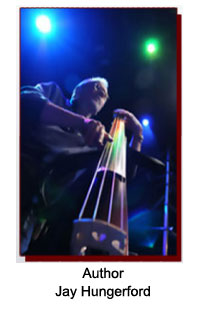 Trumpet legend Dizzy Gillespie once called the bass
"the most important instrument in any band." Whether
you agree or not, it is true the bass rarely receives the
recognition it deserves. From classical to rock to country
to jazz, the bass supports the harmony, chords and
melody. Take the bass away and it becomes difficult
for the listener to make sense of the chords and
harmonic structure.
Trumpet legend Dizzy Gillespie once called the bass
"the most important instrument in any band." Whether
you agree or not, it is true the bass rarely receives the
recognition it deserves. From classical to rock to country
to jazz, the bass supports the harmony, chords and
melody. Take the bass away and it becomes difficult
for the listener to make sense of the chords and
harmonic structure.
As a bassist, you have responsibilities. You must create
interesting lines under the chord changes, keep the
"time flow" or "pulse" steady and keep the form of the
song together. Soloist and vocalist, while being featured,
often tune in to the bass to remind them where they are
in the form of the song. An occasional missed note or
fluctuation in tempo happens to all of us. Getting lost
in the form of the tune, however, is a no-no. It will
happen and you will pick up tricks to help you get
back on track - knowing the melody, having eye
contact with the other players, and listening for cues.
This book is designed to help you create beginning to
advanced walking patterns. I've used these lesson plans
for several years and have seen even the most challenged students grow to become very
accomplished jazz bassists.
Why learn how to create an interesting walking bass line? You will find walking bass lines
in rock, blues, r&b, gospel, Latin and country. In virtually all styles of music you need to
become familiar with this style. Whether you are planning to play music for fun or as a
profession, you'll enjoy it more if you learn to walk. Switching from jazz to rock is much
easier than the reverse. Why not become proficient at all styles of music. It is more fun to
answer the phone with "sure, I can do that" rather than "well, I only know how to play
rock music."